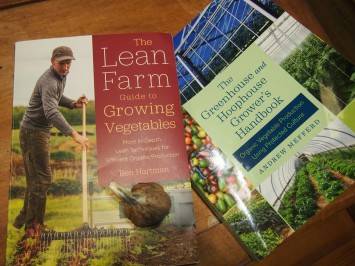Technical Education Resources for Sustainable Agriculture: The Greenhouse and Hoophouse Grower’s Handbook and The Lean Farm Guide to Growing Vegetables: A Review
Hintz JSE Fall 2017 General PDF
Both The Greenhouse and Hoophouse Grower’s Handbook and The Lean Farm Guide to Growing Vegetables from Chelsea Green Publishing fill important gaps in the field of sustainable agriculture. Both of them represent the best of the agricultural publishing tradition in that their authors are both scholars and practitioners. Both of these texts also address important innovations in sustainable agriculture and are useful teaching resources as agricultural educators struggle to address viable models of resiliency in the face of climate change. It is not often in this journal that we are able to highlight advances in technical sustainability education; I am pleased to review both of these books in that light.
The Greenhouse and Hoophouse Grower’s Handbook reviews the wide gamut of techniques now available in the field of protected growing. Borrowing much from European methods, the author, Andrew Mefferd nevertheless situates his book strongly in America, citing details about his own markets and crop variety decisions. This text is fairly unique in that Mefferd appeals both to large growers and small farmers. Though the author is thorough in covering the basics, I, as a veteran winter producer, still learned important strategies and tricks to trial in my own operation. Chapters include information on structures; heating, cooling, lighting, and irrigation; profitability; plant behavior; plant management; grafting; and top-producing crops. In his writing, Mefferd’s experience shines through as both a grower and sometime consultant through his work at Johnny’s Selected Seeds: he has both his own unique knowledge and the benefits of trouble-shooting the challenges of many growers around the country. Though he could cover many crops, he has focused here on what are generally accepted as the most profitable, and he provides important systems-minded management considerations for each of them. Though the text could benefit from more diagrams and illustrations, the writing is very clear and concise. This book will appeal to agricultural educators everywhere as a solid text on protected growing that can both serve as an introduction to the field or as an accompaniment to field experience and advanced practice.
There are a handful of agricultural texts that I return to over and over again, and that I lend my interns, require my students to read, and have dog-eared, underlined, and highlighted. The Lean Farm is one of those books, and The Lean Farm Guide to Growing Vegetables is a detailed and practical sequel to the first, germinal book. Author Ben Hartman is another writer with extensive personal expertise that he focuses with laser precision in this latest book on the key moments of vegetable production that could use greater efficiency. Hartman goes into further description of his application of lean principles originally used in Japanese car manufacturing, a field that at first might seem antithetical to sustainable farming. His premise is that greater incremental efficiency on his small farm frees up considerable time for a better work/life balance over the course of the year. Hartman’s work stands as a rigorously tested manifesto that bigger is not necessarily better in agriculture. Chapters include planning, bed preparation, compost, seed-starting, transplanting, weeds and pest management, sales, and others. The book’s photos and tables make Hartman’s operation very accessible, and the format of the text makes it easy to find material again for reference. This will be a highly useful text for both agricultural educators and food systems educators looking for resources for urban farming; the techniques Hartman discusses are very well suited to the intensive production needed in urban areas. Hartman also fills an important gap in agricultural literature, focusing on small-scale production, a style I believe will continue to grow as local food demand continues to rise. Appendices on tools, seed varieties, and enterprise budgets on a per-bed scale will be highly useful for growers looking to fine-tune their operations, and educate their interns on the details that can make or break a farm.











 Clare Hintz is the editor in chief of the Journal of Sustainability Education. Clare has a Ph.D. in Sustainability Education with a focus on Regenerative Agriculture. She has been teaching sustainable agriculture and permaculture since 1998, and has additionally developed curricula for the University of Wisconsin, River Falls, University of Minnesota, Duluth, Northland College, and Prescott College. She is a permaculture consultant in the Midwest, U.S. Her research focuses on arts-informed inquiry, regenerative agriculture, place, and ecofeminism. You can see more of her work at www.elsewherefarm.com.
Clare Hintz is the editor in chief of the Journal of Sustainability Education. Clare has a Ph.D. in Sustainability Education with a focus on Regenerative Agriculture. She has been teaching sustainable agriculture and permaculture since 1998, and has additionally developed curricula for the University of Wisconsin, River Falls, University of Minnesota, Duluth, Northland College, and Prescott College. She is a permaculture consultant in the Midwest, U.S. Her research focuses on arts-informed inquiry, regenerative agriculture, place, and ecofeminism. You can see more of her work at www.elsewherefarm.com. 
